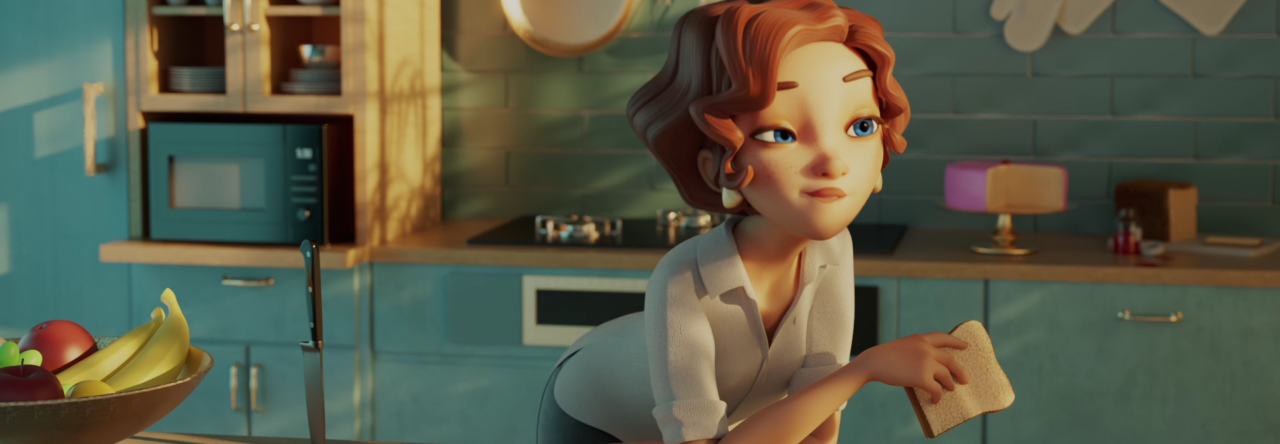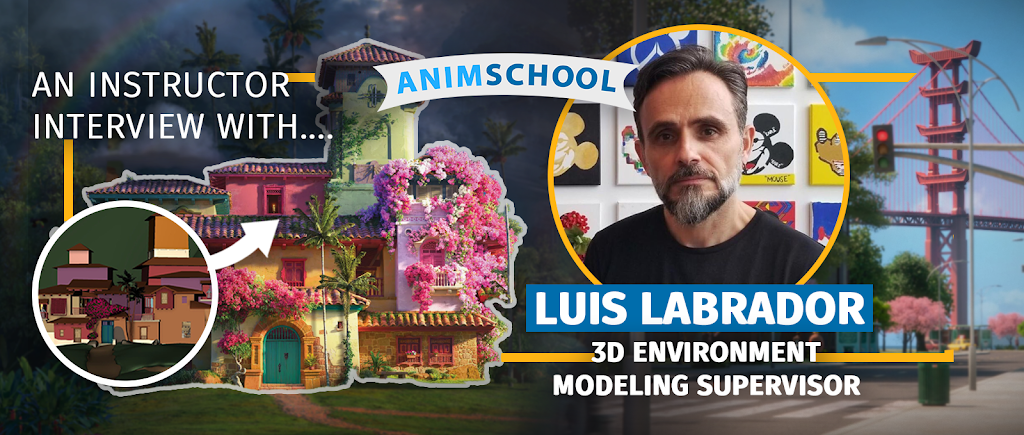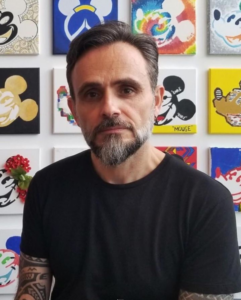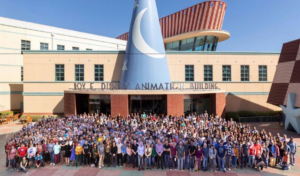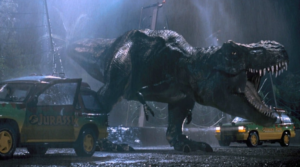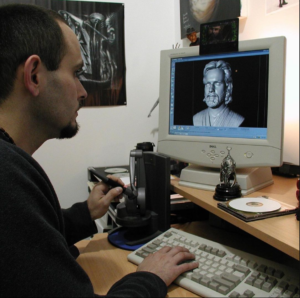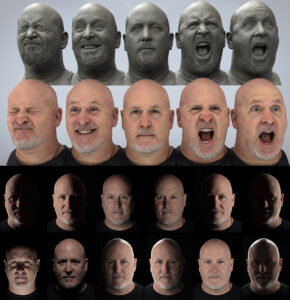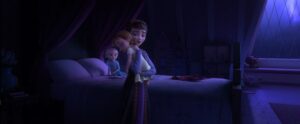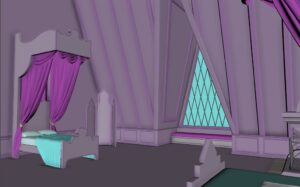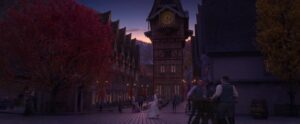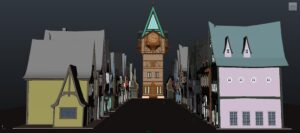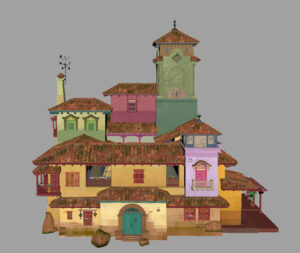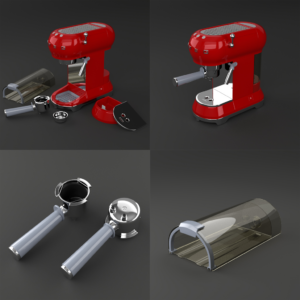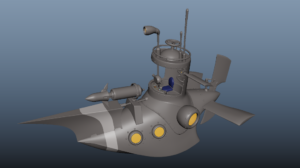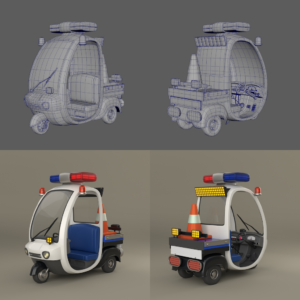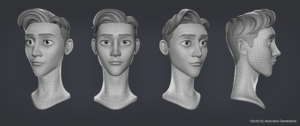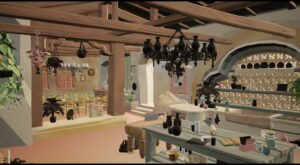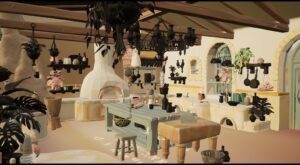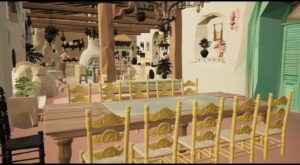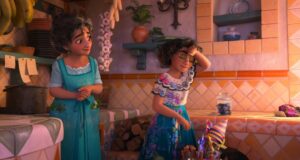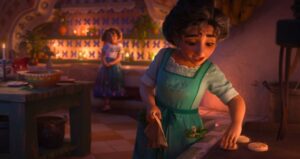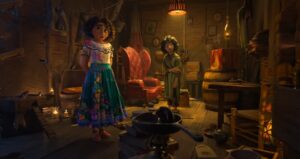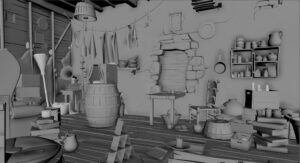For over two decades, Luis Labrador has established a prominent reputation in the 3D visual effects and animation industry as a skilled 3D modeling artist. Luis began his career as a special makeup effects artist in Spain in the early 1990’s. His professional path took a new direction after he watched “Jurassic Park” in 1993. Seeing the CG generated dinosaurs sparked his interest in pursuing a career in 3D.
He got his start in 3D character scanning at Gentle Giant Studios in 1999, where he contributed to noteworthy films such as “Spider-Man 2,” “Van Helsing,” and “Pirates of the Caribbean: The Curse of the Black Pearl.” In 2003, Luis joined Sony Imageworks and contributed to a range of films, including “I Am Legend,” “Open Season,” “Watchmen,” and several others. In 2008, he got bit by the animation bug and moved on to work at DreamWorks Animation Studios. There, he served as a 3D Character Modeler and contributed to several successful films, including “Puss in Boots,” “Kung Fu Panda 2,” and “How to Train Your Dragon.”
Currently, Luis works as a 3D Environment Modeling Supervisor at Walt Disney Animation Studios where he’s been since 2011. During his time there, he has been involved in notable projects such as “Frozen,” “Big Hero 6,” and “Encanto.” In his free time, Luis also dedicates himself to teaching 3D Modeling to students from around the world through AnimSchool and ANIMUM Creativity Advanced School. His virtual classroom has seen numerous students pass through its doors, many of whom are now working in the industry today.
Tell us about yourself and your journey into the animation industry.
My name is Luis Labrador. I’m originally from Spain and I moved to the United States when I was 20 years old. I started my career in film in Spain as a special makeup effects artist. I used to do makeup, animatronics, and monsters. In Spain, in the 90’s for visual effects there was
not that much work. I worked for two and a half years with Colin Arthur, he worked in special makeup effects and did “The NeverEnding Story”. In the 1990’s, there’s a movie that some of you might have heard about called “Jurassic Park”. That changed everything for me. Meaning that I saw the dinosaur or the part of the dinosaur that was done in CG and I thought to myself “Oh my God, I’m out of a job here! I need to learn how to do that.” That is when I decided to move to the United States in 1996.
There was no teaching of this type of discipline at that time. It was just a bunch of crazy people trying to figure it out. Most of the people were located at ILM at that time or some other studios. There was no setup for schools or teaching. There were some modeling classes around in really prestigious schools but there was nothing oriented to animation. For that reason, I’m totally self-taught.
I bought a computer, I got software and I trained myself. I had never started a computer before I moved to the United States to tell you the truth. I didn’t know how to start a computer. My twin brother, he’s really into computer science and he’s the one who guided me to what computer to buy and I started learning by myself. Working normally weekends 9-5 every day and then after 5, I used to go with my friends. But every weekend I would work 9-5, Saturday and Sunday because I worked during the weekdays. That’s how I started really learning 3D, it was all self-taught. That’s still what I do if I want to get better at something.
Can you give us a summary of studios/film projects you’ve worked on?
Students get excited about the studios that I worked at but I always have to add this at the very beginning: It’s a really rare case that a student starts right off the bat in a big studio. It takes some time. You need to build your portfolio. That is the same case with me, I started at a smaller studio called Gentle Giant Studios. I stayed with them for four and a half years. At the beginning I was just a traditional sculptor there and then I moved into the digital area when they knew that I knew how to run Maya. Nobody knew how to run Maya in the studio at that time.
I started working in 3D scanning, digital doubles for film and that’s when we worked with Sony on “Spider-Man 2”. They saw my work and asked me to join Sony. I stayed with Sony Imageworks for five and a half years. Sony had Sony Picture Animation at the time. One of the first movies was “Open Season” and “Monster House”. I got bit by the animation bug so I knocked at DreamWorks Animation’s door and I stayed with them for three and a half years.
Then I knocked at Disney Animation’s door and they said “Yea, I come in!” I’ve been with them for 11 years. I’ve worked on different projects as a 3D Artist and some as a 3D Environmental Modeling Supervisor.
What are some of your favorite movie projects you’ve worked on?
The one that I had the best experience with was “Frozen 2”. Not just for the movie or what we built, which was great and fun, it was for the experience with the people that we were working with. All the supervisors and the artists and everything on that movie. We were having so much fun. It didn’t matter how many hours you had to put in, it was a great group of people, and a great group of Supervisors. They had no ego. You learned a lot from them and they were the best people to work with. I always make this joke about when I work on a movie: I don’t really care that much after all these years about what the movie is about, it’s a plus if you like it. I always said if we do the most horrible story ever but we had the greatest people doing it and it’s fun to work on, get me into that movie. Frozen had everything. I made the joke that the planets align at that time.
My second favorite one was “Encanto”. “Encanto” was actually pretty nice to work on. Not as good as “Frozen 2”, but still pretty good. I worked on those two as a supervisor.
As an artist, I really enjoyed working on “Monster House”. I really like it and it was a lot of fun to work on. There are movies where we get a lot of freedom to do things, becoming more like the art department. On “Watchmen”, one of my last movies at Sony, I had to build things with no art. “I Am Legend” was also another movie that I really liked. Even though people don’t like the resolution of the zombies at the end. Our zombies had viens and detail but they changed the sequences so much we couldn’t render such high resolution. We had to release everything at a little bit lower resolution. My whole point is that it was a fun project though.
In visual effects you get to interact with some of the actors sometimes which I don’t do in animation right now. I miss that a lot. I went to travel to Argentina and also met the actors of “The Lord of the Rings” or Hugh Jackman when he was in “Van Helsing”. Or when I was having lunch with Johnny Depp, who was the nicest guy at that time. That’s the part I miss the most too. Van Helsing is a movie that I worked on where I spent two weeks in Prague, scanning actors and walking around Prague and meeting Hugh Jackman and having tequila shots with him. I will never have that at another time!
What are your thoughts on traditional Schools vs online schools?
A lot of students come to me at the end of my class of 11 weeks and I hear this a lot. It makes me feel good but at the same time it makes me feel bad for them which is this: “Luis I learned more in 11 weeks with you than four years in college”
It’s always good to have teachers that are production ready meaning people that really work in the industry. That’s not that easy to find. Students that normally work online and look at schools like this one, they’re lucky because I didn’t have that.
I would find something online but you never knew if it was good advice or bad advice or if it worked for real production. Students have somebody that can guide them. I always tell them to be really picky and do research on who is going to be teaching the class. Do your research on places like IMDb and find out what movies they worked on. Just to give you an example, I took classes in UCLA Extension when I came here, I had some teachers that were amazing. I had a teacher who worked on Star Wars doing the matte paintings in the background. You have to be really careful when you put your money, your knowledge and your time into it. The good thing is that students have access to that online. Having a teacher at UCLA was really lucky at the time. Another good thing about online classes is they can take the class from anywhere. You don’t have to live in California anymore. The only thing that I would say is not as good is just the loss of interaction between students. It’s good to have students connecting in person. There’s forums and stuff like that but I think they miss that personal touch, which is the only negative part that I see. Being able to take a class in your pajamas is also a big plus!
You teach a lot of international students from many countries. What advice do you give to them in regards to breaking into the industry?
The key or golden ticket for these students is their portfolio. That’s the only thing. If a studio wants what they see in your portfolio and they want you to work with them they will move the Earth just to give you a Visa. They don’t care, whatever it costs. I see cases like this at
Disney all the time, artists that have been in Europe for a long time and have an amazing portfolio. I have my friend Manu Arenas who is one of the best 2D art directors that I’ve seen in my life. Studios chase him like crazy just to get him into the studio. For two years, they were after him. What I mean by this is if you have an amazing portfolio to show, they will do anything to get you to work for them.
That’s the key. Get an amazing portfolio. If you’re kind of equal to somebody that’s here in the United States, guess what, they’re gonna go for the person. It’s going to be cheaper and take less time compared to you. Unluckily for everybody, all of immigration is becoming more and more complicated every year for every country. I know that even from where I’m from, in Spain. Trying to get a Visa is more complicated so it is happening everywhere.
Other than the portfolio, what other qualities do you look for in a candidate for hire?
The portfolio is 60 percent and this is the other 40 percent: they need to be clean with their work. They need to have clean topology and they need to be good at transferring from 2D to 3D. Normally when I ask to see someone’s portfolio, a lot of people tend to just show their models. The beautiful part and that’s it. With only that, I just know 40 percent of what you know how to do. You’re not showing me your models. I don’t see a wireframe pass so I can see your topology and if it’s ready for animation. Is it ready for texturing?
You need to show me topology and it has to be correctly done for all the other departments. Our models not only have to look pretty, they need to be functional. I know a lot of models that look pretty and then I turn on the mesh and it turns out we cannot work with it. They need to add a turntable and need to credit the concept artist and show what the design is. You need to put the 2D image. I want to see that image first and then your model so I can see it related to that. How do I know that you did a good job of translating that from 2D to 3D?
What excites you about this generation of up and coming artists that you’re teaching? What unique challenges do you think they hace compared to your own experience?
The challenges that they’re gonna face, it’s that there’s more competition now. There’s more people actually doing this but also there’s more places to work for. So on the other end, it kind of balances out. What excites me for them is that they have a lot of new things coming up that I didn’t have at that time. Things like VR, AR. Augmented reality and VR are still in diapers running around and sucking the thumb. People don’t know what’s coming in the next couple of years. I know that at the end of 2023 and 2024, this is gonna explode. They have all that possibility there, which we never had. I think that all these new technologies are something that is really cool and now it’s not just modeling for animation or for video games. There’s more stuff out there and more coming.
What are your thoughts on AI Art?
I don’t like it, let’s put it this way. I understand the use of it for some specific things. If you are a visual development person and you have a portfolio already and you have years of experience, you can use that as a tool to generate some quick ideas. Then do your own thing completely. I like the inspirational use of it, I think that’s good. The bad part is a lot of people are gonna be cheating with this. Meaning, if I had to hire somebody for 2D, how do I know their portfolios will be AI generated? How do I know if they’re good or not? How do I know if I put them in production that they’re not going to know what to do? That’s because they’re cheating through the whole process. So I see it as a tool to inspire and as a tool to build from.
Have you seen and/or experienced a culture shift over the last 20 years with the rise of communities such as “Women in Animation”, “Rise Up Animation”, Latinx in Animation, etc?
Yesah I’ve definitely seen it. Which is good, I’m diversity, look at this accent! Diversity is always good. Diversity with quality, we need to have both. Let’s make sure that we get quality at the same time that’s key. If you’re trying to find somebody you need to give yourself a little more time to be more specific about what you’re looking for but they’re definitely out there. Take your time, find them and most of the time, they’re better than any other people that you want but you need to do your research.
What’s it like being a supervisor at Disney?
I have from 8 to 12 modelers working for me depending on the show. I always say, they don’t work for me, I work for them. I work by this metaphor: They’re driving Ferraris and it’s a road that is in the mountains and I’m going first with a gigantic tractor, plowing all the snow for them so they can go super fast. That’s what supervising is for me. It’s also about being respectful with other people. Don’t have an ego. I work for them to allow them to have the best chance and clean their paths so they can be fast and precise at what they do.
How do you add character to 3D environment pieces?
We’re really oriented by the art so we can not deviate too much from that. For us, it’s having a good relationship with the 2D Department. If you don’t have a good relationship and you start doing your own thing then you’re gonna be in trouble. Apart from having reviews that you show to people in the studio, you also have working sessions with the art department. You can build a foundation in those working sessions almost like a playground for kids. The art department sometimes can be a little bit tense working around Artist and that’s not a good thing. If you collaborate and build a friendly environment, those meetings and working sessions can be really relaxed and you can laugh and even joke sometimes. Throw a joke so people relax and think “oh this is not really so serious”. If I’m with the production designer or the art director modeling in front of them I would want them to feel like we can do things together. Even though there’s collaboration there’s going to be times where they’re going to tell you “No”. Even saying no, they need to tell you in a way that by the end when they’re done telling you “No”, you look at the person and you get it and you say thank you. They need to be nice. That’s one of the things I learned from one of my supervisors Sean Jenkins. He’s an amazing supervisor. Even when he tells you “No”, you realize why it’s a no.
That’s good supervising right there.
What are some of the important concepts you try to emphasize in your class that you feel students need to learn before going into a studio?
Collaboration and understanding that they’re not just creating a model and then throwing it out there. Whoever is getting the model needs to not have to finish your work. They shouldn’t be fixing your model. I see that happening alot. You’re always gonna get some feedback no matter what. You might have minor changes but I don’t want people sening their model out and somebody has to redo most of the job. I run my class like it’s a studio and the reason I do that is because you want to work in a studio. The quality of topology for animation is really different to topology for games. Here we’re doing topology for animation. This includes subdivisions and using only quads. But if you model for animation to start with and you model everything in quads, your foundation in topology as a modeler once you do games it’s gonna be so much easier. It’s always easier to go from something that perfect and clean to something for games than the opposite. The cleanest modelers in the world come from the era of NURBS because everything needs to be patches and when everything moved to polygons everything stayed super clean
The same thing goes for animation. When you learn animation techniques of topology this will allow you to move into games where you are allowed to do triangles and it will be easy to model.
What’s next for you? Are there any other facets of the industry you want to try out?
I’m always learning by myself. I’m getting more into Unreal right now. I’m building my own art pieces right now, grabbing some design from somebody that I like and then modeling the whole thing in Maya, texturing in Substance and presenting in Unreal with lighting. I think it looks beautiful. What I think is coming in the future is AR and VR. Nobody knows what’s going to become the Metaverse. Someone asked me the other day in a conference “What is the metaverse?” My answer was “Whoever told you what the metaverse is, is lying to you because nobody knows what it’s going to be. It’s going to be something amazing but for now it is not. With the technology getting better you can look forward to the metaverse.
What do you say to those who stop growing and learning?
You need to keep evolving. The industry is evolving so if you don’t evolve with the industry, you’re going to be out of a job. There’s a lot of new things coming out every single day from photogrammetry modeling and procedural modeling. We need to keep learning.
Things are becoming a little more complicated but you get into the network and mostly if you want to sell your portfolio as a student to other people but companies are getting a little bit picky with showing portfolios and making it harder. It used to be a bit more free. It’s still good to go to those events because you get to know people and show your work so definitely going is a plus. I went to Lightbox instead of CTN and I really liked Lightbox. For students that’s the place to go because you see where the industry is going and you meet other people, you make friends in the industry and other students in other schools.
I use it as an excuse to see friends from other studios that I haven’t seen in years and we go out to dinner too.
Why do you like teaching at AnimSchool?
I like it because they’re serious about what they do. It’s a school that also has a tradition which is good. It’s one of the first ones. You only have to look at the panel of teachers and can see that these people mean business. It’s also legal in a way that everything is accredited. You have other schools that are not really number one. They don’t have the teachers or they don’t have the qualifications. I treat the students with a lot of appreciation and a lot of respect and the school treats me with respect as a professional and not just as a teacher.
We have fun and everything but seriously when we mean business we’re doing a good business. We’re actually teaching people that are actually working now. That makes you feel good. Mutual respect is the key and professionalism that’s number one so for me that’s why.

